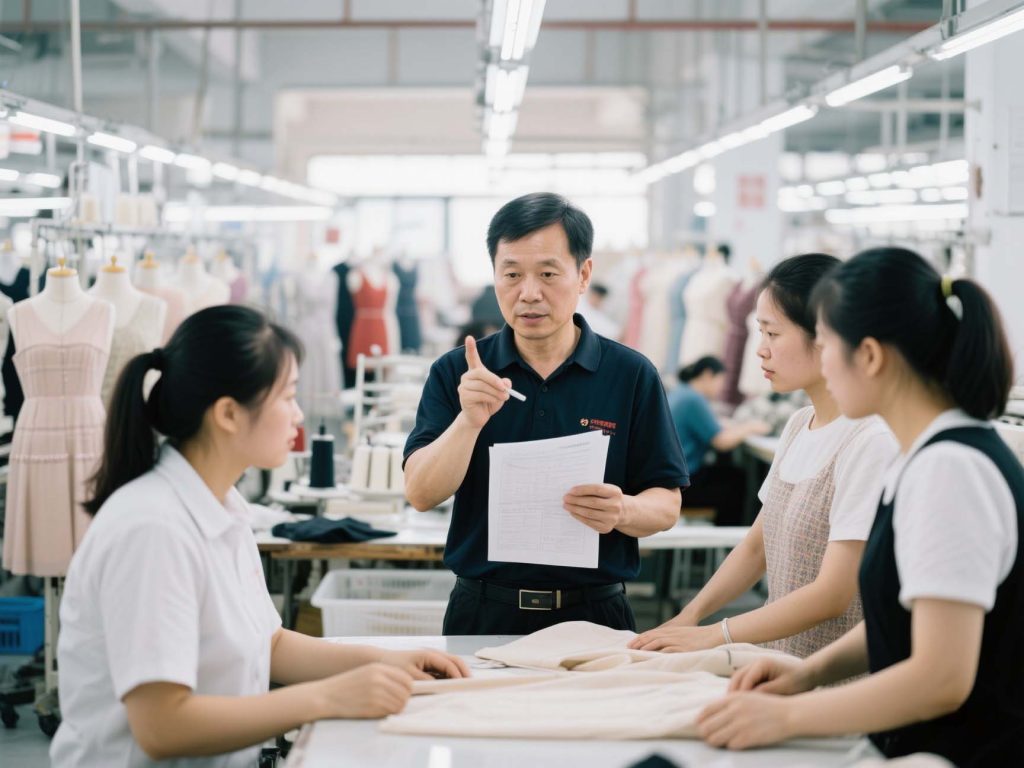The garment manufacturing process involves transforming a design into bulk production while ensuring quality, consistency, and efficiency. Below is a detailed breakdown of the workflow, tailored for clarity and alignment with international standards.

1. Pre-Production Preparations
Before bulk production begins, thorough preparation is critical to avoid delays, errors, and additional costs.
Key Steps:
Finalize Design Specifications
Confirm all details with the client: fabric type, color, size range (e.g., XS–XL), quantity per size, labeling, and packaging requirements.
Create a Production Sample
Develop a final “golden sample” that incorporates all client-approved adjustments. This sample serves as the reference for bulk production.
Size Grading
Scale the base size (e.g., size S) into other sizes using standardized grading rules. Accuracy is vital, as incorrect grading affects fabric cutting and garment fit.
Production Details Form
Prepare a document outlining:
Supplier details (fabric, trims, accessories).
Fabric color codes and quality standards.
Production timeline, QC requirements, and packaging instructions.
2. Production Execution
Once pre-production is complete, the manufacturing phase begins:
Step-by-Step Workflow:
Pattern Grading Validation
Verify grading consistency (e.g., bust, neckline, shoulder seams) to ensure patterns align with the approved size specifications.
Fabric and Trim Procurement
Secure bulk fabric and trims. Confirm color accuracy against the sample, as dye lots may vary. Prioritize suppliers with confirmed stock availability to avoid delays.
Production Planning
Develop a timeline for cutting, sewing, and finishing. Monitor progress to ensure deadlines are met and communicate updates to the client.
Fabric Calculation and Cutting
Calculate fabric requirements per size to minimize waste. Pre-shrink stretch fabrics (e.g., knits) to maintain size accuracy post-production.
Cutting Process
Precision-cut fabric panels using graded patterns. Errors here can lead to sizing issues or material waste.
Pre-Production Meeting
Align with the production team on quality standards, timelines, and troubleshooting protocols.
3. Assembly and Quality Control
Sewing
Begin stitching components once all materials and approvals are in place. Design changes at this stage are strongly discouraged to avoid delays.
In-Process Inspection (IPI)
Conduct quality checks on initial pieces to identify deviations (e.g., stitching defects, sizing issues). Address issues immediately.
Final Sewing
Complete all units after IPI approval. Monitor workflow efficiency and resolve bottlenecks promptly.
Final Quality Control (FQC)
Inspect finished garments for:
Adherence to size specifications.
Seam strength and stitching quality.
Compliance with packaging guidelines.
Document findings and share a report with the client.
4. Finishing and Delivery
Pressing and Finishing
Steam or press garments to enhance appearance and ensure crisp seams.
Thread Trimming and Packaging
Trim loose threads and pack garments according to client instructions (e.g., size/color segregation, carton labeling).
Third-Party Inspection (Optional)
If requested, schedule a final inspection post-packaging to verify compliance with international standards (e.g., AQL, ISO).
Why Preparation Matters
Meticulous pre-production minimizes risks in bulk operations. Errors in early stages (e.g., incorrect grading or fabric procurement) can cascade into costly delays. Investing time upfront ensures smoother execution, on-time delivery, and client satisfaction.
This streamlined process aligns with global best practices, emphasizing transparency, quality assurance, and efficient communication. For further customization or specific certifications, please contact our team.
Why Choose Us?
We’re not just manufacturers—we’re partners. From design to delivery, we prioritize:
✅ Transparency: Regular updates, no hidden steps.
✅ Flexibility: Need a last-minute tweak? Let’s talk!
✅ Quality Obsession: Your brand’s reputation is ours too.
Ready to Start?
Let’s turn your ideas into wearable art! Drop us a message—we’re excited to collaborate. 🚀

